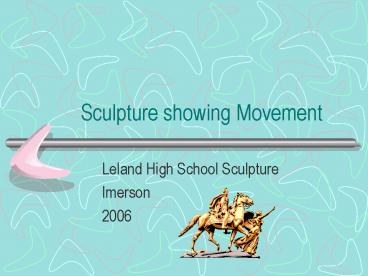Sculpture showing Movement - PowerPoint PPT Presentation
1 / 26
Title:
Sculpture showing Movement
Description:
It can be brushed and poured. The putty stage. The putty stage is very brief. ... wet it really clogs tools and they have to be steel brushed cleaned quite often. ... – PowerPoint PPT presentation
Number of Views:44
Avg rating:3.0/5.0
Title: Sculpture showing Movement
1
Sculpture showing Movement
- Leland High School Sculpture
- Imerson
- 2006
2
Drawing plans will help create success
3
Gather visuals of humans in action poses
- Sports-soccer, basketball, football, rugby,
lacrosse, running, hockey etc. - Dancing-think of the different types of dancing
for ideas - Martial Arts
- Skiing, Surfing
- Your own idea indicating an emotion or other
content that indicates movement
4
Armature
- Internal supports are often required for plaster
work. - Some provide strength
- Some provide weight
- reduction creating volume
- that saves on plaster
5
Gause with plaster already in it will make our
process easier
- We will use small bowls to dip the strips in
briefly before adding to the armature - Never Never take these bowls near the sinks.
- They will dry out and be used again the next day.
- We will use buckets for hand
- Cleaning (I will cover sinks
- with wood)
6
We will mix plaster to add to milk cartons for
another carving experience
The following slides show the stages plaster goes
through as it dries. We may use additional
plaster for the action sculptures on the wire
armature.
7
Use a flexible container
- Fill the plastic paint pail no more than 1/3 full
of water to allow room for the plaster and mixing
procedure. Begin sifting plaster through the
fingers into the water.
8
As the plaster begins to fill the water, it will
finally begin to float.
9
At this time, temporarily stop adding plaster
- Until the plaster in the bucket is dissolved.
- Slowly add more plaster as it becomes saturated.
- The mixture should sit for 3 or 4 minutes prior
to further mixing. - After it sits, proceed by stirring with hands.
More plaster can be added if it is needed but it
is not a good idea.
10
Mix thoroughly and accurately
- Take care not to add too much or too little
plaster and to mix the plaster thoroughly without
mixing too long, thereby losing the
setting-working time for the plaster. - Plaster can be squeezed between the fingers to
force lumps apart.
11
It is like cream
- When the plaster completely covers the hand to
where the skin color no longer shows through,
then it is ready to use. - If the mixture is too liquid, it will not set for
a long time and be too weak or soggy to be of
value. - If the mixture is too thick, it is difficult to
use. It will set extremely fast and form a very
hard, glassy,unworkable plaster.
12
Plasters are very safe to use.
- They are non-toxic and nonallergenic except for
floating dust while mixing.
13
Mixing times
- Mixing for 3 minutes will allow a possible 30
minutes of working time before setting. - Mixing for 8 minutes will allow only 12 minutes
prior to hard setting.
14
Cautions
- Always mix plaster into water, never water into
plaster. - Add plaster in a sifting manner.
- Thoroughly mix
- Never pour a plaster mixture in a sink or drain,
since it can set up underwater.
15
The liquid stage
- This occurs right after mixing. It will last
from five to fifteen minutes depending upon the
water ratio and so on. - It can be brushed and poured.
16
The putty stage
- The putty stage is very brief.
- It can be scooped, applied with a putty knife or
spatula and modeled much like clay.
17
The Rigid Stage
- This is when the mixture noticeably is beginning
to set. The plaster will no longer bend without
cracking or crumbling but can easily be cut and
trimmed with a knife or dug into with a spoon. - The plaster is extremely fragile and should not
be vibrated, dropped or have pressure on it.
18
The Set Stage
- This is when the plaster begins to heat up and
becomes obviously hard. - The faster the plaster sets the hotter it
becomes.
19
The Cure Stage
- Working during this time requires hard tools
(metal rasps, files and the like) - Since the plaster is still wet it really clogs
tools and they have to be steel brushed cleaned
quite often. - Any additional plaster has to be added to a
thoroughly pre-soaked plaster surface in order to
take hold.
20
The dry stage
- This is when the plaster no longer contains
moisture. - The surface can be sanded or painted. It is
futile to use sandpaper beyond 220 grit because
of the denseness of the material.
21
Cleaning up
- Cleanup is made easier if the work surface is
covered with sheet plastic. - Hands should be cleaned promptly in a bucket of
water (never the sink) before the plaster
hardens. This refers to if you have had your
hands in the plaster mixing, not when using the
gause with pre-added plaster, which will not be
bad at all.(I will show you) - Use a good hand lotion after washing to prevent
chapping.
22
Flowing clothing can indicate movement
23
The Egyptians were famous for static sculpture,
no movement is indicated here
24
Dramatic poses can indicate motion
25
Accessories can help add drama
26
Animals in human clothing add interest































